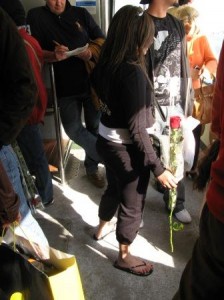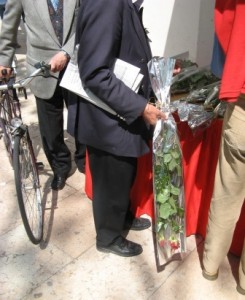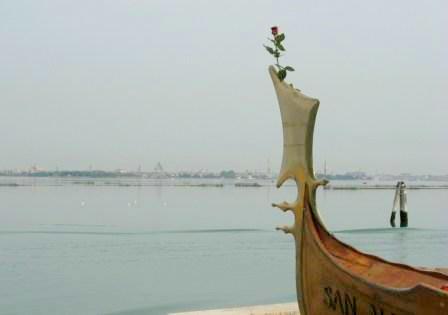
Venice was never without a patron saint, but for the first several centuries of its existence that task was assigned to a Greek soldier saint, Theodore of Amasea (“Todaro,” in Venetian).

In that era Venice was still technically a colony of Byzantium, and a saint’s being Latin or Greek had as much political as religious significance. By 828, though, Venice had begun to reach a level of importance, and independence, which convinced its rulers that they needed to upgrade their guardian. A Latin saint now looked better than a Greek one, and why stop there? They aimed for one of the four Evangelists, Saint Mark, whose body was known to repose in Alexandria, Egypt.
And so they went and stole him. Two intrepid sailors, known to history as “Buono” of Malamocco and “Rustico” from Torcello (unquestionably noms de guerre), spirited the body of the city’s erstwhile bishop out of the Muslim metropolis by hiding it on a wagon covered in pig carcasses (and also cabbage leaves, which was the Venetian way of conserving meat, between alternating layers of lard and cabbage. The Bible compares humans to grass, but Venetians are more realistic).
This exploit highlights two of the most fundamental Venetian traits: shrewdness and audacity. And in case “Good” and “Rustic” appear to have been improbably daring and clever, some scholars have made a good case for their having bribed the shrine’s guardian. The point here, as in much of Venetian history, is that it worked. For my money, the appropriate motto for the Old Ones wouldn’t be the legendary “Pax tibi, Marce, evangelista meus” [Peace to you, Mark, my evangelist] which is inscribed on the book most of his symbolic winged lions are holding, but a straightforward “Get it done.”
In the great days, Venice observed not one, but four celebrations of its saint:
- January 31, the “translation” (well, theft) of his remains, which was popularly called San Marco dei mezeni, because the body had been concealed between (in mezzo) the aforementioned pork and cabbage;
- April 25, his martyrdom. This is the big day for us, and it is called the festa del bocolo, or feast of the long-stemmed rose;
- June 25, the finding of his relics (fancy word for corpse), which had inexplicably gone missing during or after the great fire in the basilica in 976. Legend has it that a priest was led to the site of the concealed body by a powerful scent of roses, so not only did the liturgy involve a priest sprinkling the altar with rosewater, the day itself was referred to as San Marco dell’acqua rosata, or Saint Mark of the rosewater. Roses again. I have to look into that.
- October 8, the dedication of the basilica, which had been built specifically to honor and preserve his body. Ordinary people called this simply San Marco de le zizoe, the Venetian word for jujubes, a popular but transient little autumn fruit here which is like a date made of styrofoam. I buy them at least once just so I can say the word: ZEE-zo-eh. It makes me smile. There is, in fact, more to say about them, but I’ll save that for another time.
All this wasn’t just because Mark deserved it. Venice’s masters loved pomp not only for itself but because they knew how to exploit it. They made a point of creating celebrations around an enormous number of events — saints’ days, deliverance from plagues (twice), military victories, even military defeats. All that was necessary was that Venice had to have been the star. It worked extremely well, because all of this festivizing kept civic pride bubbling away, ready for use at any moment. You weren’t even to imagine that there could be anything better than being a Venetian, and ceremonial was a dependable way to keep that fact front and center in your average Venetian’s brain.
Back to the body. There is a body under the high altar, and it is labeled as being Mark’s. Lino doesn’t believe it. I don’t know if this counts as heresy, but being a good Venetian, he doesn’t care. He makes a good case: For one thing, he says, it’s pretty suspicious that the body is never venerated, not even on April 25. For another, he says that when Angelo Roncalli (patriarch of Venice from 1953-1958) became Pope John XXIII, he gave an important (unidentified) relic to the church in Alexandria. Lino tells me this with that “What more do I need to say” look.
What it all comes down to today is the long-stemmed red rose, the longer and redder the better.
The custom is for a man to give one to the woman — or women — he loves. Could be his wife, mother, sister, girlfriend, cousin. No protocol on this, except for the wife or girlfriend, which are non-negotiable. Anyway, as roses were costing at least five euros each this year, the typical man’s list has probably been cut back to the minimum.
Lino is a traditionalist to the bone, or in this case, the rose. He would go without lunch and possibly even without wine, if he had to, but he would never skip the rose.
He even gives a rose to our club’s eight-oar gondola, or gondolone. Of course she is named “San Marco.”





1 Comment